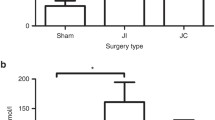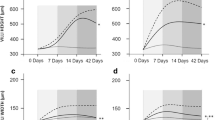Abstract
Background
There are no in vivo methods to measure adaptation in neonatal short bowel syndrome (SBS). We evaluated citrulline (Cit) levels in neonatal piglet surgical models of SBS.
Methods
Piglets underwent 75% mid-intestinal resection with jejunoileal anastomosis (JI), 75% distal resection of ileum with jejunocolic anastomosis (JC) or sham surgery. Jugular and gastric catheters were inserted for parenteral and enteral nutrition. On D7, small intestine length and weight were measured, jejunum collected for histopathology and Cit level determined.
Results
JI (n = 5) compared to JC (n = 5) had increased small intestinal length (JC − 17.5 cm; JI +22.0 cm; p = 0.02) and mass (JC 43.1 mg/cm/kg; JI 51.3 mg/cm/kg; p = 0.02), while Cit did not differ (JI 801.0 µM; JC 677.7 µM; p = 0.90). Including non-resected shams (n = 4), Cit correlated with length (R2 = 0.48; p = 0.006), but not for SBS alone (R2 = 0.11; p = 0.4), mass (R2 = 0.05; p = 0.5). A second experiment compared change in Cit levels from baseline to D7. Levels declined in sham (n = 8) and JC (n = 10) (sham − 110.1 µM; JC − 56.6 µM; p = 0.17), regardless of intestinal lengthening (sham 29.9 cm; JC − 10.4 cm; p = 0.002).
Conclusion
Citrulline levels predict large differences in intestinal length and ‘identify’ SBS. However, citrulline cannot discriminate between adaptation in JI and JC, nor predict intestinal lengthening.

Similar content being viewed by others
Abbreviations
- SBS:
-
Short bowel syndrome
- EN:
-
Enteral nutrition
- PN:
-
Parenteral nutrition
- JI:
-
Jejunoileal anastomosis anatomy
- JC:
-
Jejunocolic anastomosis anatomy
References
O’Keefe SJ, Buchman AL, Fishbein TM, Jeejeebhoy KN, Jeppesen PB, Shaffer J (2006) Short bowel syndrome and intestinal failure: consensus definitions and overview. Clin Gastroenterol Hepatol 4(1):6–10. https://doi.org/10.1016/j.cgh.2005.10.002
Sukhotnik I, Siplovich L, Shiloni E, Mor-Vaknin N, Harmon CM, Coran AG (2002) Intestinal adaptation in short-bowel syndrome in infants and children: a collective review. Pediatr Surg Int 18(4):258–263. https://doi.org/10.1007/s003830100695
Chandra R, Kesavan A (2018) Current treatment paradigms in pediatric short bowel syndrome. Clin J Gastroenterol 11(2):103–112. https://doi.org/10.1007/s12328-017-0811-7
Algin O, Evrimler S, Arslan H (2013) Advances in radiologic evaluation of small bowel diseases. J Comput Assist Tomogr 37(6):862–871. https://doi.org/10.1097/RCT.0b013e318299658c
Raman M, Fenton T, Crotty P, Ghosh S, Rioux K, Hundal R (2015) A novel method to identify fat malabsorption: the Serum retinyl palmitate test. Clin Chim Acta 438:103–106. https://doi.org/10.1016/j.cca.2014.08.001
Crenn P, Coudray-Lucas C, Cynober L, Messing B (1998) Post-absorptive plasma citrulline concentration: a marker of intestinal failure in humans. Transpl Proc 30(6):2528
Crenn P, Messing B, Cynober L (2008) Citrulline as a biomarker of intestinal failure due to enterocyte mass reduction. Clin Nutr 27(3):328–339. https://doi.org/10.1016/j.clnu.2008.02.005
Kohler ES, Sankaranarayanan S, van Ginneken CJ, van Dijk P, Vermeulen JL, Ruijter JM, Lamers WH, Bruder E (2008) The human neonatal small intestine has the potential for arginine synthesis; developmental changes in the expression of arginine-synthesizing and-catabolizing enzymes. BMC Dev Biol 8:107. https://doi.org/10.1186/1471-213x-8-107
Lim DW, Levesque CL, Vine DF, Muto M, Koepke JR, Nation PN, Wizzard PR, Li J, Bigam DL, Brubaker PL, Turner JM, Wales PW (2017) Synergy of glucagon-like peptide-2 and epidermal growth factor coadministration on intestinal adaptation in neonatal piglets with short bowel syndrome. Am J Physiol Gastrointest Liver Physiol 312(4):G390–G404. https://doi.org/10.1152/ajpgi.00281.2016
Josephson J, Turner JM, Field CJ, Wizzard PR, Nation PN, Sergi C, Ball RO, Pencharz PB, Wales PW (2015) Parenteral soy oil and fish oil emulsions: impact of dose restriction on Bile flow and brain size of parenteral nutrition-fed neonatal piglets. JPEN J Parenter Enteral Nutr 39(6):677–687. https://doi.org/10.1177/0148607114556494
Cisler JJ, Buchman AL (2005) Intestinal adaptation in short bowel syndrome. J Investig Med 53(8):402–413
Crenn P, Vahedi K, Lavergne-Slove A, Cynober L, Matuchansky C, Messing B (2003) Plasma citrulline: a marker of enterocyte mass in villous atrophy-associated small bowel disease. Gastroenterology 124(5):1210–1219
Crenn P, Coudray-Lucas C, Thuillier F, Cynober L, Messing B (2000) Postabsorptive plasma citrulline concentration is a marker of absorptive enterocyte mass and intestinal failure in humans. Gastroenterology 119(6):1496–1505. https://doi.org/10.1053/gast.2000.20227
Curis E, Crenn P, Cynober L (2007) Citrulline and the gut. Curr Opin Clin Nutr Metab Care 10(5):620–626. https://doi.org/10.1097/MCO.0b013e32829fb38d
Fragkos KC, Forbes A (2018) Citrulline as a marker of intestinal function and absorption in clinical settings: a systematic review and meta-analysis. United Eur Gastroenterol J 6(2):181–191. https://doi.org/10.1177/2050640617737632
Belza C, Fitzgerald K, de Silva N, Avitzur Y, Steinberg K, Courtney-Martin G, Wales PW (2017) Predicting intestinal adaptation in pediatric intestinal failure: a retrospective cohort study. Ann Surg. https://doi.org/10.1097/sla.0000000000002602
Gutierrez IM, Fisher JG, Ben-Ishay O, Jones BA, Kang KH, Hull MA, Shillingford N, Zurakowski D, Modi BP, Jaksic T (2014) Citrulline levels following proximal versus distal small bowel resection. J Pediatr Surg 49(5):741–744. https://doi.org/10.1016/j.jpedsurg.2014.02.056
Stultz JS, Tillman EM, Helms RA (2011) Plasma citrulline concentration as a biomarker for bowel loss and adaptation in hospitalized pediatric patients requiring parenteral nutrition. Nutr Clin Pract 26(6):681–687. https://doi.org/10.1177/0884533611425682
Diamanti A, Panetta F, Gandullia P, Morini F, Noto C, Torre G, Lezo A, Goffredo B, Daniele A, Gambarara M (2011) Plasma citrulline as marker of bowel adaptation in children with short bowel syndrome. Langenbeck’s Arch Surg 7:1041
Bailly-Botuha C, Colomb V, Thioulouse E, Berthe MC, Garcette K, Dubern B, Goulet O, Couderc R, Girardet JP (2009) Plasma citrulline concentration reflects enterocyte mass in children with short bowel syndrome. Pediatr Res 65(5):559–563. https://doi.org/10.1203/PDR.0b013e31819986da
Fitzgibbons S, Ching YA, Valim C, Zhou J, Iglesias J, Duggan C, Jaksic T (2009) Relationship between serum citrulline levels and progression to parenteral nutrition independence in children with short bowel syndrome. J Pediatr Surg 44(5):928–932. https://doi.org/10.1016/j.jpedsurg.2009.01.034
Bourdon A, Rougé C, Legrand A, Robert CD, Piloquet H, Vodovar M, Voyer M, Rozé J-C, Darmaun D (2012) Urinary citrulline in very low birth weight preterm infants receiving intravenous nutrition. Br J Nutr 108(7):1150–1154. https://doi.org/10.1017/s0007114511006660
Rabier D, Kamoun P (1995) Metabolism of citrulline in man. Amino Acids 9(4):299–316. https://doi.org/10.1007/bf00807268
Luo M, Fernández-Estívariz C, Manatunga AK, Bazargan N, Gu LH, Jones DP, Klapproth JM, Sitaraman SV, Leader LM, Galloway JR, Ziegler TR (2007) Are plasma citrulline and glutamine biomarkers of intestinal absorptive function in patients with short bowel syndrome? JPEN J Parenter Enteral Nutr 31(1):1–7
Fjermestad H, Hvistendahl M, Jeppesen PB (2017) Fasting and postprandial plasma citrulline and the correlation to intestinal function evaluated by 72-hour metabolic balance studies in short bowel jejunostomy patients with intestinal failure. JPEN J Parenter Enteral Nutr. https://doi.org/10.1177/0148607116687497
Melis GC, Boelens PG, van der Sijp JRM, Popovici T, De Bandt J-P, Cynober L, van Leeuwen PAM (2007) The feeding route (enteral or parenteral) affects the plasma response of the dipetide Ala-Gln and the amino acids glutamine, citrulline and arginine, with the administration of Ala-Gln in preoperative patients. Br J Nutr 94(1):19–26. https://doi.org/10.1079/BJN20051463
Acknowledgements
The authors wish to acknowledge the important contribution of Charlane Gorsak for technical assistance with the study and all the staff of the Swine Research and Technology Centre, University of Alberta.
Funding
This work was Funded by the Canadian Institutes of Health Research (Grant Number: MOP-126179).
Author information
Authors and Affiliations
Corresponding author
Ethics declarations
Conflict of interest
Author Marihan Lansing declares that she has no conflict of interest. JM Turner has research grant funding from GLyPharma Therapeutic, Inc., and from Empire Biotechnologies Inc. Author Pamela Wizzard declares that she has no conflict of interest. Author Celeste M. Lavallee declares that she has no conflict of interest. Author David W. Lim declares that he has no conflict of interest. Author Mitsuru Muto declares that he has no conflict of interest. Author Patrick N. Nation declares that he has no conflict of interest. Author Paul B. Pencharz declares that he has no conflict of interest. Author Ron O. Ball declares that he has no conflict of interest. Author Paul W. Wales has research grant funding from GLyPharma Therapeutic, Inc., and from Empire Biotechnologies Inc.
Human and animal rights
All applicable international, national, and/or institutional guidelines for the care and use of animals were followed.
Additional information
Publisher's Note
Springer Nature remains neutral with regard to jurisdictional claims in published maps and institutional affiliations.
Rights and permissions
About this article
Cite this article
Lansing, M., Turner, J.M., Wizzard, P. et al. Plasma citrulline is not a biomarker for intestinal adaptation in short bowel syndrome, studied in piglets: a model for human neonates. Pediatr Surg Int 35, 657–663 (2019). https://doi.org/10.1007/s00383-019-04475-4
Accepted:
Published:
Issue Date:
DOI: https://doi.org/10.1007/s00383-019-04475-4




